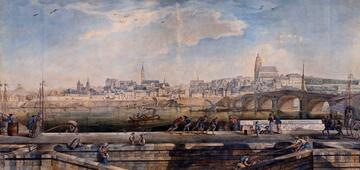During the first part of this field-trip, students stopped in
Orleans where they were able to gain practice in
reading the landscape with Philippe Auclerc from the
magazine,
Loire
et terroirs, by comparing the present day docks with old
prints. Bearing in mind the aim of restoring continuity with the
town itself, they were thus able to observe the results of an
ambitious reconstruction of the docks that has been carried out
in
Orleans: the stone used for the docks,
terraced gardens and architecture, the restrictions imposed on the
routes dedicated to road traffic.
A meeting at the Centre for Nature and the Environment was
the venue for a study of the
position of a nature reserve in an outlying suburban
zone.
The second part of the field-trip took place in the Paris
region. Assistance with its organisation had been provided by the
office of Denis BAUPIN, deputy to the Mayor of Paris responsible
for transport, traffic, parking and highways. It provided an
opportunity to find out about the action carried out by Voies
navigables de France (Navigable Routes in France) and the Port
autonome de Paris (Independent Port of Paris), responsible for
management of the Seine docks within the capital. The visit
continued at PC Lutèce (the Paris traffic monitoring centre),
which manages road traffic in real time and carries out forecasting
work on traffic movements in the city. A particularly interesting
presentation explained the
impact of actions already carried out in relation to roads
along riverbanks: speed reduction to 50 kilometres an
hour, closure on Sundays or during Paris Plage. It also made it
possible to understand the
issues raised in relation to transport by the
reconstruction.
Other visits provided opportunities to find out about
actions taken to promote ancient or industrial heritage
(respectively, the Medici Aqueduct and the former Meunier chocolate
factory on the Canal Saint-Martin).
The stay ended on the subject of river navigation with a
visit to the Museum of Boat-building at Conflans Sainte Honorine.
This field study made it possible for students to gain a
grasp of the issues connected to reconstruction of riverbanks in
urban and outlying suburban zones both in relation to promotion of
heritage and in terms of transport and movement or tourism and
leisure pursuits.
Further details from:
IMACOF
(Engineering in Aquatic Environments and River Corridors)